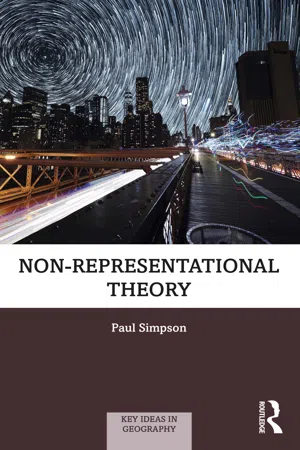
Non-representational Theory
Paul Simpson
- 254 pages
- English
- ePUB (mobile friendly)
- Available on iOS & Android
Non-representational Theory
Paul Simpson
About This Book
Non-representational Theory explores a range of ideas which have recently engaged geographers and have led to the development of an alternative approach to the conception, practice, and production of geographic knowledge. Non-representational Theory refers to a key body of work that has emerged in geography over the past two and a half decades that emphasizes the importance of practice, embodiment, materiality, and process to the ongoing formation of social life. This title offers the first sole-authored, accessible introduction to this work and its impact on geography.
Without being prescriptive the text provides a general explanation of what Non-representational Theory is. This includes discussion of the disciplinary context it emerged from, the key ideas and themes that characterise work associated with Non-representational Theory, and the theoretical points of reference that inspires it. The book then explores a series of conjunctions of 'Non-representational Theory and...', taking an area of geographic enquiry and exploring the impact Non-representational Theory has had on how it is researched and understood. This includes the relationships between Non-representational Theory and Practice, Affect, Materiality, Landscape, Performance, and Methods. Critiques of Non-representational Theory are also broached, including reflections on issues on identity, power, and difference.
The text draws together the work of a range of established and emerging scholars working on the development of non-representational theories, allowing scholars from geography and other disciplines to access and assess the animating potential of such work. This volume is essential reading for undergraduates and post-graduate students interested in the social, cultural, and political geographies of everyday living.
Frequently asked questions
1
Non-representational theories and geography
Introduction
Origin stories
the on-going impact of post-structuralism on the discipline [of geography] and, in particular, the avenues for thought opened by the translation of the work of Deleuze and Latour; an emergent concern for ‘everyday life’ and the forms of embodied practice therein; a specific confluence of energies, research interests and institutional setting focused on the School of Geographical Sciences in Bristol in the UK throughout the 1990s; the gathering together and elaboration of non-representational theories by Nigel Thrift; the crystallisation of desires to find new ways of engaging space, landscape, the social, the cultural and the political; the influence of the UK’s Research Assessment Exercise [now Research Excellence Framework] through which, in Human Geography at least, value was attached to single author papers and which promoted an academic climate wherein so called ‘theoretical’ interventions could be valued as highly as more ‘empirical’ studies; a simple generational shift between the New Cultural Geography and what would follow; an ever more extensive engagement by geographers with other social science and humanities disciplines; a cynical careerist fabulation.
New Cultural Geography and its ‘dead geographies’
contemporary as well as historical (but always contextual and theoretically informed); social as well as spatial (but not confined exclusively to narrowly-defined landscape issues); urban as well as rural; and interested in the contingent nature of culture, in dominant ideologies and in forms of resistance to them. It would, moreover, assert the centrality of culture in human affairs.
Box 1.1 The Cultural Turn
A hardly problematised sphere of representation is allowed to take precedence over lived experience and materiality, usually as a series of images or texts which a theorist contemplatively deconstructs, thus implicitly degrading practices.
Box 1.2 Post-structuralism and geography
profoundly suspicious of anything that tries to pass itself off as a simple statement of fact, of anything that claims to be true by virtue of being ‘obvious’, ‘natural’, or based upon ‘common sense’. As a philosophy and a set of methods of doing research, post-structuralism … exposes all such claims as contingent, provisional, subject to scrutiny and debate.
human beings are engaged in building discursive worlds by actively constructing webs of significance which are laid out over a physical substrate. In other words, human beings are located in a terrain which appears as a set of phenomena to which representations must be affixed prior to any attempt at engagement.
Table of contents
- Cover
- Half Title
- Series Page
- Title Page
- Copyright Page
- Dedication
- Table of Contents
- List of figures
- List of boxes
- Acknowledgments
- Introduction
- 1 Non-representational theories and geography
- 2 Non-representational theories and practice
- 3 Non-representational theories and affect
- 4 Non-representational theories and materiality
- 5 Non-representational theories and landscape
- 6 Non-representational theories and performance
- 7 Non-representational theories and method
- Concluding
- References
- Index